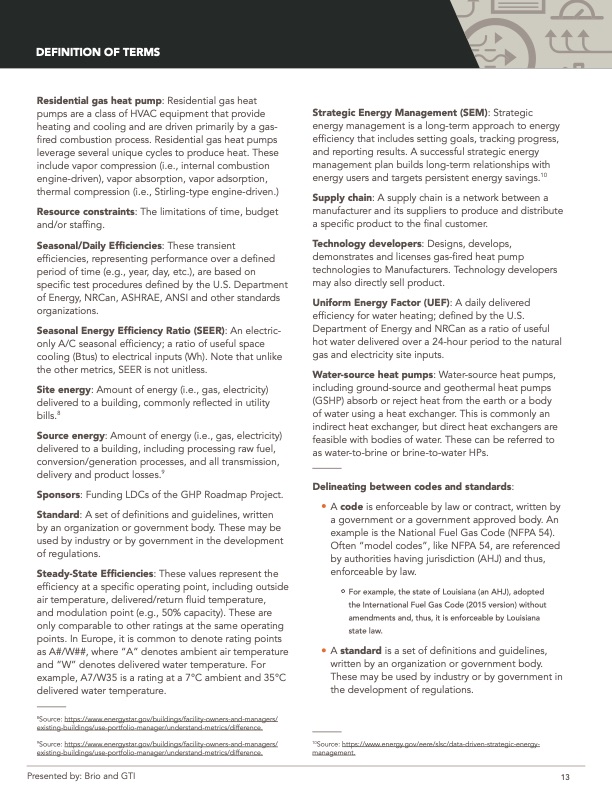
PDF Publication Title:
Text from PDF Page: 013
DEFINITION OF TERMS Residential gas heat pump: Residential gas heat pumps are a class of HVAC equipment that provide heating and cooling and are driven primarily by a gas- fired combustion process. Residential gas heat pumps leverage several unique cycles to produce heat. These include vapor compression (i.e., internal combustion engine-driven), vapor absorption, vapor adsorption, thermal compression (i.e., Stirling-type engine-driven.) Resource constraints: The limitations of time, budget and/or staffing. Seasonal/Daily Efficiencies: These transient efficiencies, representing performance over a defined period of time (e.g., year, day, etc.), are based on specific test procedures defined by the U.S. Department of Energy, NRCan, ASHRAE, ANSI and other standards organizations. Seasonal Energy Efficiency Ratio (SEER): An electric- only A/C seasonal efficiency; a ratio of useful space cooling (Btus) to electrical inputs (Wh). Note that unlike the other metrics, SEER is not unitless. Site energy: Amount of energy (i.e., gas, electricity) delivered to a building, commonly reflected in utility bills.8 Source energy: Amount of energy (i.e., gas, electricity) delivered to a building, including processing raw fuel, conversion/generation processes, and all transmission, delivery and product losses.9 Sponsors: Funding LDCs of the GHP Roadmap Project. Standard: A set of definitions and guidelines, written by an organization or government body. These may be used by industry or by government in the development of regulations. Steady-State Efficiencies: These values represent the efficiency at a specific operating point, including outside air temperature, delivered/return fluid temperature, and modulation point (e.g., 50% capacity). These are only comparable to other ratings at the same operating points. In Europe, it is common to denote rating points as A#/W##, where “A” denotes ambient air temperature and “W” denotes delivered water temperature. For example, A7/W35 is a rating at a 7°C ambient and 35°C delivered water temperature. 8Source: https://www.energystar.gov/buildings/facility-owners-and-managers/ existing-buildings/use-portfolio-manager/understand-metrics/difference. 9Source: https://www.energystar.gov/buildings/facility-owners-and-managers/ existing-buildings/use-portfolio-manager/understand-metrics/difference. Strategic Energy Management (SEM): Strategic energy management is a long-term approach to energy efficiency that includes setting goals, tracking progress, and reporting results. A successful strategic energy management plan builds long-term relationships with energy users and targets persistent energy savings.10 Supply chain: A supply chain is a network between a manufacturer and its suppliers to produce and distribute a specific product to the final customer. Technology developers: Designs, develops, demonstrates and licenses gas-fired heat pump technologies to Manufacturers. Technology developers may also directly sell product. Uniform Energy Factor (UEF): A daily delivered efficiency for water heating; defined by the U.S. Department of Energy and NRCan as a ratio of useful hot water delivered over a 24-hour period to the natural gas and electricity site inputs. Water-source heat pumps: Water-source heat pumps, including ground-source and geothermal heat pumps (GSHP) absorb or reject heat from the earth or a body of water using a heat exchanger. This is commonly an indirect heat exchanger, but direct heat exchangers are feasible with bodies of water. These can be referred to as water-to-brine or brine-to-water HPs. Delineating between codes and standards: A code is enforceable by law or contract, written by a government or a government approved body. An example is the National Fuel Gas Code (NFPA 54). Often “model codes”, like NFPA 54, are referenced by authorities having jurisdiction (AHJ) and thus, enforceable by law. For example, the state of Louisiana (an AHJ), adopted the International Fuel Gas Code (2015 version) without amendments and, thus, it is enforceable by Louisiana state law. A standard is a set of definitions and guidelines, written by an organization or government body. These may be used by industry or by government in the development of regulations. 10Source: https://www.energy.gov/eere/slsc/data-driven-strategic-energy- management. Presented by: Brio and GTI 13PDF Image | GAS HEAT PUMP TECHNOLOGY AND MARKET ROADMAP

PDF Search Title:
GAS HEAT PUMP TECHNOLOGY AND MARKET ROADMAPOriginal File Name Searched:
2019-heat-pump-roadmap.pdfDIY PDF Search: Google It | Yahoo | Bing
CO2 Organic Rankine Cycle Experimenter Platform The supercritical CO2 phase change system is both a heat pump and organic rankine cycle which can be used for those purposes and as a supercritical extractor for advanced subcritical and supercritical extraction technology. Uses include producing nanoparticles, precious metal CO2 extraction, lithium battery recycling, and other applications... More Info
Heat Pumps CO2 ORC Heat Pump System Platform More Info
| CONTACT TEL: 608-238-6001 Email: greg@infinityturbine.com | RSS | AMP |